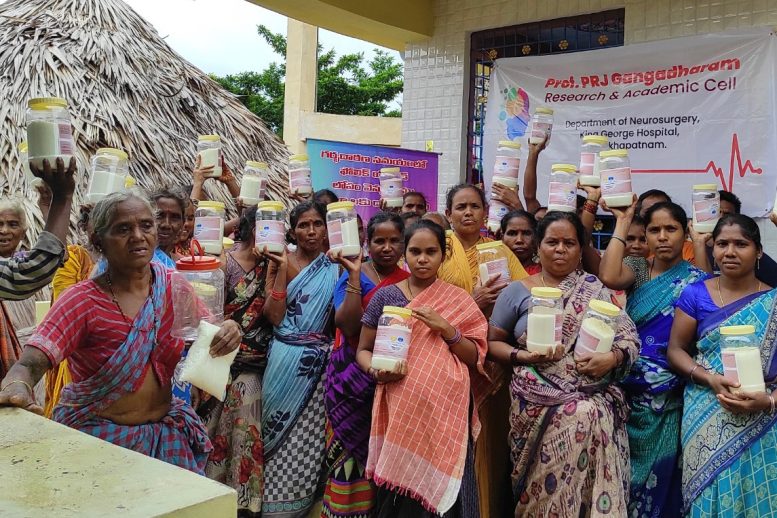
A groundbreaking study has shown that adding folic acid to iodized table salt can effectively prevent critical birth defects, offering a simple, affordable preventive measure for global implementation.
A team of international researchers—including experts from the University of Central Florida and Emory University—has proven, for the first time in a field study, that using folic acid-fortified iodized table salt can prevent multiple severe birth defects.
The importance of women having enough folic acid in their bodies before and during pregnancy to prevent permanent and life-threatening birth defects, such as spina bifida and anencephaly, has been known for decades. The World Health Organization recommends that all women should take supplement pills with 400 micrograms of folic acid daily, from the moment they begin attempting to conceive through the first three months of pregnancy.
Mandatory staple food fortification with folic acid is a cost-effective, safe, and equitable way to address the issue. In May 2023, the World Health Assembly adopted a resolution promoting food fortification with folic acid to accelerate the slow pace of prevention of spina bifida and other birth defects associated with low maternal folate levels at the time of early pregnancy.
Yet approximately 260,000 births worldwide—about 20 per every 10,000 births—are still affected by spina bifida and anencephaly, contributing to a high number of stillbirths, elective pregnancy terminations, and deaths of infants and young children.
The problem
While folic acid has been added through mandatory staple grain food fortification in about 65 countries, including the United States, more than 100 countries have yet to implement fortification due to challenges that include limited capacity for large-scale fortification of staple grains in these regions or lack of political will.
A solution
A new study recently published by JAMA Network Open showed that a solution is not only possible, many people already have it on their kitchen tables.
The clinical trial showed that mixing folic acid to commercially available iodized table salt, based on the existing average daily consumption of salt, increased serum folate levels among participants to levels needed for the prevention of spina bifida and anencephaly. The increase was significant, a 3.7-fold improvement before and after a four-month period of using the study salt with iodine and folic acid.

The participants of an international study on the effectiveness of adding folic acid to iodized table salt in the prevention of serious birth defects hold containers of the fortified salt they received as part of the study. Credit: University of Central Florida
“We proved that folic acid can get into the blood through salt. Hopefully, countries that have not already implemented fortification programs can now look at their infrastructures and realize that salt fortification is cheap and it’s really easy to add in the amount of folic acid needed to save lives,” says Jogi Pattisapu, MD, the study’s lead author and a neurosurgeon from UCF’s College of Medicine. “It might just turn the salt a little yellow, but the participants did not mind and we know it works. What we need now is action.”
Why it matters
Pattisapu credits the study’s successful outcome to the collaborative nature of the research team, specifically the efforts and expertise of researchers from Emory University’s Rollins School of Public Health and the colleagues from multiple institutions in India, who co-led the study and recruited and monitored the 83 non-pregnant women—who were between the ages of 18-45, from four different villages in southern India—who consumed the folic acid-fortified salt as part of their regular diet during a four-month period in 2022. India has a high prevalence of spina bifida and anencephaly.
“Work was done there, by the Indian team, for their cause,” Pattisapu says. “That was very important, and it is a powerful message.”
Even though food fortification is mandatory in the United States, the researchers say the impact of this new study could be felt globally in countries with successful salt iodization programs.
“This is a global goodwill involving the health of mothers and babies. We are making sure we apply the knowledge we have,” says Vijaya Kancherla, an associate professor in the Department of Epidemiology at Rollins. “These are preventable birth defects and once it happens, you cannot cure it. Surgeries and clinical care are expensive and largely not available in low- and middle-income countries. Due to that, most babies with spina bifida die globally. So, it is a human rights issue that everyone should be worried about and should strive to find alternate solutions that prevent these conditions from occurring in the first place, no matter where one is born. We show that salt has the potential to close the prevention gap now.”
The researchers also made it clear the study does not promote salt intake, but rather adding the necessary amount of folic acid to the table salt that residents of these regions are already consuming. If the average daily salt consumption is reduced in these regions, the concentration of folic acid would simply be increased, to meet the need. This approach is already used in grain fortification program.
The researchers said at least 50 percent of the current global spina bifida cases would be prevented if the major, already existing iodized salt programs took the simple step of adding folic acid.
“We now know folic acid fortification of iodized salt can prevent folate deficiency that causes spina bifida,” says Godfrey Oakley Jr., MD, director of the Center for Spina Bifida Prevention at Rollins. “The stage is now set for a rapid acceleration of prevention of these birth defects in many countries”
Reference: “Folic Acid–Fortified Iodized Salt and Serum Folate Levels in Reproductive-Aged Women of Rural India: A Nonrandomized Controlled Trial” by Jogi V. Pattisapu, Vijayasekhar V. Manda, Madhu Narayana Rao Kottakki, Phani Madhavi Kajana, Vijaya Kancherla, Hayagriva Rao Bhaganagarapu, Vigneshwar Veerappan, Achuith Ediga, Venkatesh Mannar, Levente Diosady and Godfrey P. Oakley, 8 March 2024, JAMA Network Open.
DOI: 10.1001/jamanetworkopen.2024.1777









SciTechDaily also recently presented an article about lowering cardiovascular risks using potassium chloride salt substitute, which I was ahead of the curve on. I use Good Salt, which is fortified with lysine, magnesium, and iodine. Add some folic acid, and you will have good salt in the neonatal. I offer anecdotal evidence That switching to that salt has reduced my BP numbers and the occurrence of foot and leg edema, as well as correcting my electrolyte imbalances, confirmed by blood work.